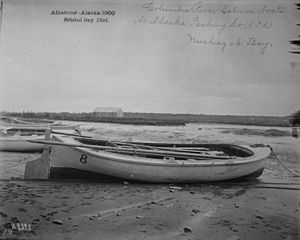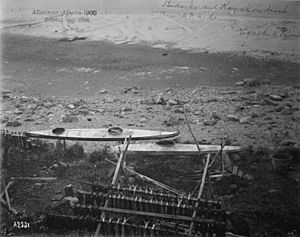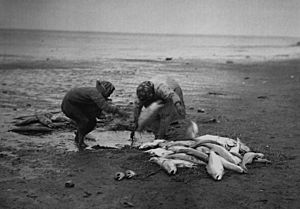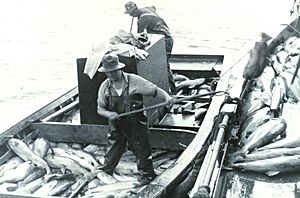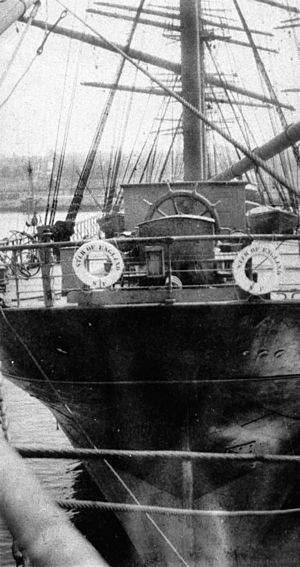Alaska Packers' Association facts for kids
The Alaska Packers' Association (APA) was a large company based in San Francisco. It was famous for canning salmon in Alaska. The company started in 1891 and was sold in 1982.
The APA was the biggest salmon packer in Alaska. Its canneries were important in local areas. The company also had a lot of influence in politics. The Alaska Packers' Association is best known for its "Star Fleet." This was the last group of commercial sailing ships on the West Coast of North America. They were used until 1927.
Contents
How the APA Started
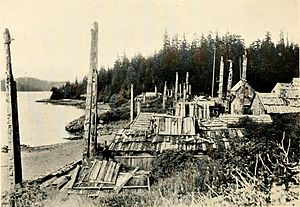
The APA was created in 1891. At that time, the Alaska salmon industry was new. But it was already making more canned salmon than people wanted to buy.
The association first formed to sell all the extra salmon. It did so well that it became a company in 1892. Its new name was the Alaska Packing Association. This helped them better control how much canned salmon was made. Out of 31 original canneries in Alaska, 9 were closed that year. With a few small changes, the company became the Alaska Packers Association in 1893.
Henry Frederick Fortmann was a key leader. He owned the Arctic Packing Company, one of the first members. He was the APA president from the start until 1922. He stayed on the board until he passed away.
Growing Bigger
As the salmon industry grew, the APA became the largest salmon packer in Alaska. Its canneries were located all over, from Bristol Bay to Southeast Alaska. The company's canneries had special names. They used "Diamonds" followed by a letter. For example, Diamond NC was their cannery in Clark's Point, Alaska. Diamond E was in Egegik.
Canned salmon was the biggest industry in Alaska back then. It brought in over 80% of the territory's tax money. The APA had a lot of power in Juneau, the capital, and in Washington DC. This is where the government made rules for fishing.
Some Alaskans did not like how much power the APA had. They felt the company was too focused on making money. The APA used its power to make sure fishing rules didn't hurt their business too much. They also got other benefits. For example, the company ran salmon hatcheries. These were places where they raised baby salmon. They got tax credits for releasing these young salmon. In 1907, the APA canned salmon worth over $3 million. But thanks to credits for their hatcheries, they paid very little in taxes.
However, the APA also helped Alaskans when needed. Their cannery hospitals gave medical care to local Native people. In 1919, a terrible flu spread across western Alaska. The APA helped bury the many people who died. They also cared for the sick and for children who lost their parents. This happened even when the government didn't offer much help.
Company Changes
In 1916, the Alaska Packers Association joined with other companies. They formed a new company called California Packing Corporation (CalPack). This new company also dealt with canned fruits, vegetables, and pineapple. Later, CalPack became Del Monte Foods. The APA then moved its main office to the Seattle area.
The company generally did well through the 1930s as salmon production increased. But many Alaska canneries closed during World War II and never reopened. During World War II, the Alaska Packers' Association helped by operating merchant ships. These ships carried goods for the United States.
After the war, salmon numbers went down. This was due to too much fishing in the past and changes in ocean conditions. Many APA canneries were old and needed big repairs. But the company wondered if it was worth spending money to fix them. Salmon numbers were low, and people were starting to prefer cheaper tuna.
Salmon production in Alaska stayed low through the 1950s, 60s, and early 70s. In 1982, when salmon numbers started to improve, most of the APA's properties were sold. They were bought by ConAgra, a company from Omaha, Nebraska. Today, many of these properties in Bristol Bay are owned by Trident Seafoods.
The Star Fleet
The APA is perhaps best remembered for its "Star Fleet." This was one of the last groups of tall ships (large sailing ships). Using wind power instead of steam helped the company save money. The salmon canning business was seasonal, and old sailing ships were cheap and easy to find.
Around 1900, the APA started buying iron-hulled ships. These were stronger than wooden ones. They bought several ships from another company's "Star Line." The first ship they bought was the Star of Russia. The APA liked the "Star of..." naming style so much that they used it for all their other ships. They named them Star of Alaska, Star of Finland, and so on. By 1930, most of the sailing ships were replaced with ships that used steam or diesel engines.
Alaska's tough weather caused some accidents with these sailing ships. The most famous was the sinking of the Star of Bengal on September 20, 1908. The ship was being pulled from Wrangell, Alaska. It had its full crew and over 2.5 million cans of salmon on board. A strong storm hit when they reached the open ocean. The boats pulling it cut their lines, and the ship's anchors couldn't hold. The 262-foot ship broke apart on the rocks of Coronation Island. Sadly, 111 people died, mostly cannery workers.
In 1927, the APA still owned fourteen square-rigged sailing ships in its "Star Fleet." Only two of these ships remain today. The Star of India is now at the Maritime Museum of San Diego. The Star of Alaska, originally named the Balclutha, was given its original name back. It is now in San Francisco as part of the San Francisco Maritime National Historical Park.
The Star of Russia now rests underwater in Port Vila harbor, Vanuatu. It is a popular place for divers to visit. Other ships from this series that are no longer afloat include the Star of Bengal, Star of England, Star of Falkland, Star of Finland, Star of France, Star of Greenland, Star of Holland, Star of Iceland, Star of Italy, Star of Lapland, Star of Poland, Star of Scotland, Star of Shetland, and Star of Zealand.
Gallery of the Star Fleet
-
Star of Alaska, now museum ship Balclutha
-
Deck of Balclutha in Maritime National Historical Park, 2005
-
Star of India docked in San Diego, 2005
Current Status
The name APA is now used by a different group in Seattle called the At-Sea Processors Association. This group represents companies that own fishing vessels. These vessels catch and process fish like pollock and Pacific whiting in Alaska and off the West Coast. The At-Sea Processors Association has no connection to the old Alaska Packers' Association.


